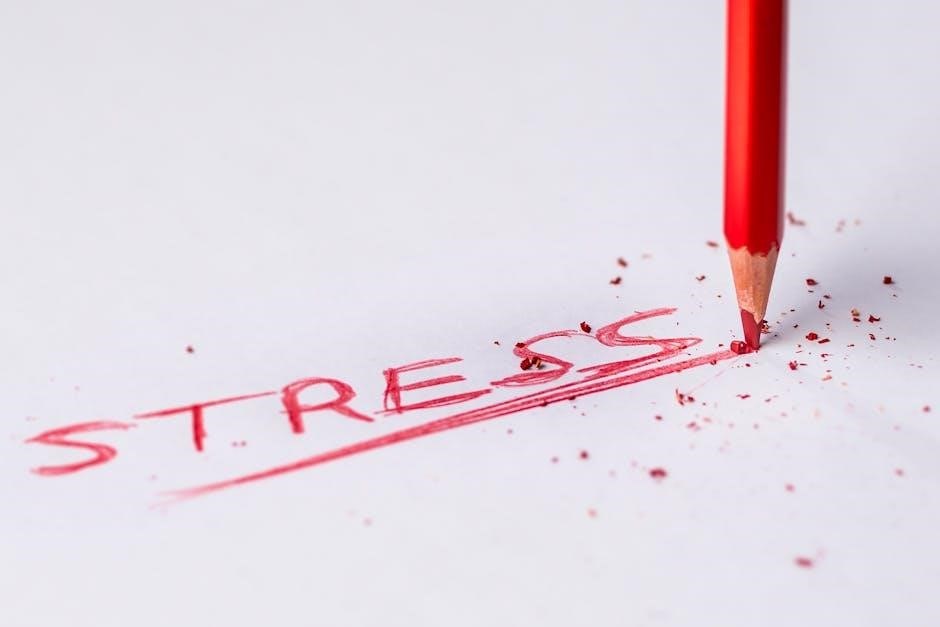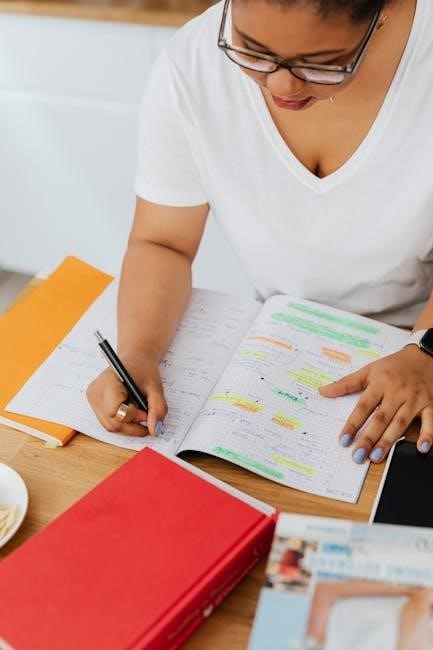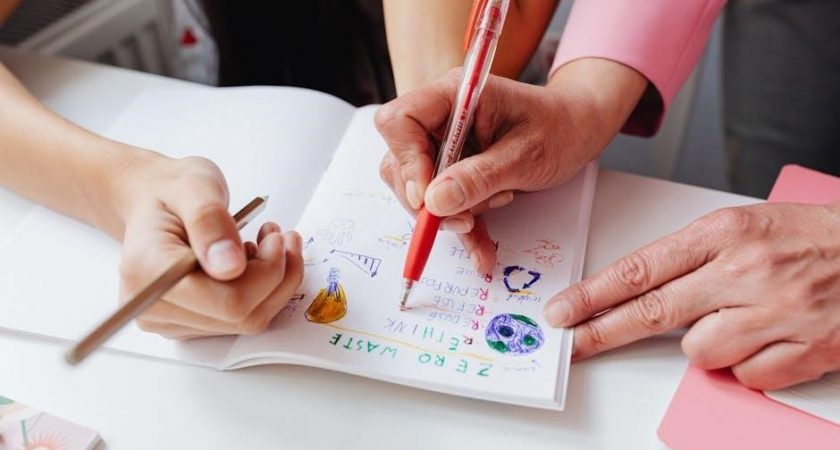Good handwriting enhances communication, boosts confidence, and leaves a positive impression. It involves proper posture, grip, and practice. This guide provides practical tips and strategies to improve handwriting through consistent practice and dedication.
1.1. The Importance of Good Handwriting
Good handwriting plays a crucial role in effective communication and self-expression. It enhances readability, making written content clearer and more professional. Legible handwriting boosts confidence, as it reflects attention to detail and care in presentation. In a digital age, it stands out as a unique skill, influencing first impressions in both personal and professional settings. Improving handwriting fosters better academic and career opportunities, emphasizing its lifelong value.
1.2. Setting Goals for Handwriting Development
Setting clear, achievable goals is essential for improving handwriting. Start by identifying specific areas for improvement, such as letter formation or consistency. Break these into short-term and long-term objectives, allowing for gradual progress. Track your advancements through regular practice and feedback. Celebrate small milestones to stay motivated and maintain consistency in your efforts to develop better handwriting skills over time.
Essential Tools for Better Handwriting
Quality tools like ergonomic pens, sharp pencils, and lined paper are vital for improving handwriting. Choose a comfortable pen and use paper with guide lines to enhance consistency and control while writing.
2.1. Choosing the Right Pen or Pencil
Choosing the right pen or pencil is crucial for improving handwriting. Opt for a pen with comfortable grip and smooth ink flow, such as a gel or fountain pen, to enhance letter formation. Pencils are ideal for practice, as they allow for easy corrections. Experiment with different tools to find what suits your hand best and ensures consistent writing quality and control.
2.2. Using Lined Paper for Consistency
Using lined paper is essential for maintaining consistency in handwriting. It helps guide letter formation, ensuring uniform height and alignment; The lines provide a clear framework, making it easier to control spacing and straighten slanted writing. Consistent use of lined paper fosters better handwriting habits and improves overall legibility, especially during practice sessions and daily writing tasks.

Basic Techniques to Enhance Handwriting
Mastering proper posture, grip, and stroke formation is key to improving handwriting. Regular practice of letter shapes and lines enhances muscle memory and writing fluidity.
3.1. Proper Posture and Hand Positioning
Proper posture and hand positioning are crucial for improving handwriting. Sit up straight with feet flat on the floor, keeping your writing arm at a 90-degree angle. Ensure your hand is relaxed, with the pen or pencil balanced between your thumb and index finger. Avoid strained grips or leaning forward, as this can lead to fatigue and uneven writing. Consistent practice of correct posture enhances control and fluidity, reducing strain during extended writing sessions.
3.2. Practicing Basic Strokes and Shapes
Practicing basic strokes and shapes is essential for improving handwriting. Regularly practice straight lines, curves, circles, and slanted lines. These exercises build muscle memory and enhance control, as they form the foundation for letter formation and overall consistency. Start with slow, deliberate movements, gradually increasing speed as coordination improves. Dedicate a few minutes daily to these drills for noticeable progress.

Cursive and Print Handwriting Practice
Mastering both cursive and print handwriting is key to versatile writing skills. Cursive enhances speed and fluidity, while print improves clarity and precision. Regular practice of both styles refines overall handwriting, ensuring legibility and consistency in all writing situations.
4.1. Benefits of Cursive Writing
Cursive writing enhances speed, fluidity, and readability. It improves letter spacing and reduces letter lifting, making writing more efficient. Cursive also strengthens muscle memory and fine motor skills, boosting overall handwriting quality. Additionally, it fosters better retention of information and promotes creativity. Mastering cursive can lead to improved academic performance and a more professional, polished appearance in written communication.
4.2. Tips for Improving Print Handwriting
Focus on consistent letter sizing and spacing by using lined paper. Practice basic strokes like vertical lines and circles to enhance control. Maintain proper posture and a relaxed grip. Slow down to ensure clarity. Regularly practice writing individual letters and words. Use a comfortable pen and pay attention to letter formation. Consistency and patience are key to improving print handwriting effectively.
Effective Practice Routines
Regular practice is essential for improving handwriting. Set aside time daily for drills and exercises. Consistency and patience will help build muscle memory and confidence.
5.1. Daily Practice Exercises and Drills
Daily practice is crucial for improving handwriting. Start with simple exercises like writing the alphabet, tracing shapes, and copying sentences. Consistency helps build muscle memory. Dedicate 10-15 minutes daily to drills, focusing on letter formation and spacing. Gradually increase complexity as skills improve. Regular practice ensures steady progress and a noticeable enhancement in handwriting quality over time.
5.2. Using Worksheets and Templates
Worksheets and templates are invaluable for structured handwriting practice. They provide guidelines for consistent letter formation, spacing, and alignment. Use tracing exercises, word copying, and blank space completion to refine skills. Templates with varying line heights and widths cater to different needs. Regular use helps develop muscle memory and improves handwriting consistency, making it easier to transition to writing without guides.

Addressing Common Handwriting Challenges
Common challenges include uneven letter spacing and inconsistent letter slant. Regular practice, focused exercises, and patience can help address these issues, leading to more polished writing.
6.1. Overcoming Sloppy or Uneven Writing
Addressing sloppy writing involves improving posture, grip, and practice consistency. Regular exercises like drawing lines and circles can enhance muscle memory. Using lined paper helps align letters properly, while relaxation techniques reduce hand tension. Slowing down and focusing on each stroke ensures clarity and uniformity in writing, leading to neater results over time;
6.2. Improving Letter Formation and Spacing
Enhancing letter formation requires practicing basic strokes and proper letter structure. Using lined paper ensures consistency in height and alignment. Focus on maintaining even spacing by leaving one character space between words. Slow down to improve accuracy and clarity. Regular drills and templates can help refine letter shapes and proportions, leading to more legible and visually appealing handwriting over time.

The Role of Muscle Memory and Relaxation
Muscle memory and relaxation are key to consistent handwriting. Regular stretching exercises and a relaxed grip improve control and fluidity, enhancing overall writing quality and comfort.
7.1. Stretching and Warm-Up Exercises
Stretching and warm-up exercises are essential for improving handwriting. Start with finger stretches, finger rotations, and wrist movements to prevent fatigue. Practice tracing circles and lines to build muscle memory. These exercises enhance dexterity, coordination, and control, laying a strong foundation for consistent and legible handwriting. Regular warm-ups ensure smooth and precise pen movements, improving overall writing quality and comfort.
7.2. Maintaining a Relaxed Grip and Hand Movement
A relaxed grip and smooth hand movement are crucial for consistent handwriting. Avoid tightening your hand, as it can lead to fatigue and uneven writing. Use a comfortable pen, keep your wrist straight, and allow your arm to move freely. Proper posture and hand positioning ensure natural flow, reducing strain and improving letter consistency. Light pressure and a steady rhythm enhance overall writing quality and readability.

Handwriting Development for Different Audiences
Handwriting development varies across age groups. Adults focus on precision and style, while children build foundational skills through play and structured exercises, fostering creativity and confidence.
8.1. Tips for Adults to Improve Handwriting
For adults, consistent practice is key. Start with short sessions, focusing on letter formation and spacing. Choose a comfortable pen and practice basic strokes. Use lined paper for consistency and maintain proper posture. Relax your grip to avoid tension. Be patient and celebrate small improvements to stay motivated and achieve lasting results.
8.2. Helping Children Develop Good Handwriting Habits
Encourage children to hold their pen or pencil correctly, using a comfortable grip; Use lined paper to guide letter size and spacing. Practice basic strokes and shapes through fun activities like tracing and coloring. Provide positive feedback and make practice enjoyable with short, engaging sessions. Consistency and patience help build confidence and improve handwriting skills over time.

The Psychological Impact of Handwriting
Good handwriting fosters confidence and self-expression, enhancing emotional well-being. It strengthens cognitive skills and creativity, creating a lasting impression in personal and professional communication.
9.1. Building Confidence Through Better Writing
Improving handwriting can significantly boost self-confidence, as it enhances self-expression and communication skills. Legible writing fosters pride in personal style, reducing anxiety in professional or academic settings. Regular practice, proper posture, and the right tools contribute to better handwriting, which in turn builds esteem and encourages positive feedback, making individuals feel more professional and assured in their abilities.
9.2. The Connection Between Handwriting and Self-Expression
Handwriting serves as a unique form of self-expression, reflecting personality and creativity. It allows individuals to convey emotions and thoughts in a personalized way. The style, spacing, and flourishes in writing are deeply connected to one’s identity, making it a powerful tool for artistic and personal communication. This connection highlights the importance of nurturing handwriting as a means of individuality and self-expression.
Modern Technology and Handwriting
Modern technology enhances handwriting through AI-powered apps, digital tools, and interactive exercises. These innovations provide real-time feedback, making practice engaging and effective for all skill levels.
10.1. Using AI and Apps to Improve Handwriting
AI and handwriting apps transform practice with personalized exercises, real-time feedback, and interactive drills. These tools enhance letter formation, consistency, and speed while catering to diverse skill levels. They offer customizable workouts, progress tracking, and motivational features, making handwriting improvement accessible and engaging for users of all ages.
10.2. The Role of Digital Tools in Handwriting Practice
Digital tools like handwriting apps and software provide interactive exercises, guided drills, and progress tracking. Apps such as Nebo and Bebo offer real-time feedback, helping users refine letter formation and spacing. These tools also include customizable templates and practice sheets, making handwriting practice engaging and effective for both children and adults. They complement traditional methods, fostering consistency and improvement.

Advanced Techniques for Refining Style
Refine your handwriting by experimenting with letterforms, flourishes, and artistic touches. Incorporate calligraphy techniques and vary line widths for a more polished and distinctive writing style.
11.1. Experimenting with Different Writing Styles
Exploring various writing styles, such as cursive, italic, or copperplate, can help refine your handwriting. Research different fonts and scripts online for inspiration. Practice replicating letterforms to develop muscle memory. Experimenting with spacing, slant, and letter connections can enhance creativity and personalization. Consistency and patience are key to mastering new styles and creating a unique, polished handwriting aesthetic.
11.2. Incorporating Calligraphy and Artistic Elements
Incorporating calligraphy and artistic elements can elevate handwriting into a creative expression. Use tools like nib pens or brushes for varying line widths and flourishes. Practice decorative lettering techniques, such as copperplate or Spencerian script. Experiment with letter height variation, swashes, and flourishes to add elegance. Guides or stencils can help refine these artistic touches, making handwriting uniquely stylish while maintaining readability.

Maintaining Progress and Consistency
Consistency is key to maintaining handwriting progress. Regular practice and positive habits ensure steady improvement. Dedication leads to lasting results and a more polished writing style.
12.1. Tracking Improvement Over Time
Regularly tracking handwriting progress helps identify improvements and areas needing attention. Use journals or apps to monitor changes, set specific goals, and celebrate milestones. Comparing past and current samples reveals development, motivating consistent practice. Feedback from others and self-assessment tools also enhance tracking accuracy, ensuring steady growth and refinement in handwriting skills over time.
12.2. Staying Motivated and Consistent in Practice
Staying motivated requires setting achievable goals and celebrating progress. Incorporate variety in practice, such as mixing drills with creative writing, to keep sessions engaging. Positive reinforcement and tracking improvements help maintain enthusiasm. Consistency is key; even short daily practice yields results over time, fostering discipline and visible improvement in handwriting skills.
